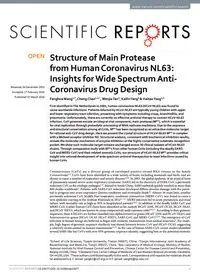
2016 Structure of Main Protease from Human Coronavirus NL63_ Insights for Wide Spectrum Anti-Coronavirus Drug Design PDF
Preview 2016 Structure of Main Protease from Human Coronavirus NL63_ Insights for Wide Spectrum Anti-Coronavirus Drug Design
1 Scientific RepoRts | 6:22677 | DOI: 10.1038/srep22677 www.nature.com/scientificreports Structure of Main Protease from Human Coronavirus NL63: Insights for Wide Spectrum Anti- Coronavirus Drug Design Fenghua Wang1,*, Cheng Chen1,2,*, Wenjie Tan3, Kailin Yang4 & Haitao Yang1,2 First identified in The Netherlands in 2004, human coronavirus NL63 (HCoV-NL63) was found to cause worldwide infections. Patients infected by HCoV-NL63 are typically young children with upper and lower respiratory tract infection, presenting with symptoms including croup, bronchiolitis, and pneumonia. Unfortunately, there are currently no effective antiviral therapy to contain HCoV-NL63 infection. CoV genomes encode an integral viral component, main protease (Mpro), which is essential for viral replication through proteolytic processing of RNA replicase machinery. Due to the sequence and structural conservation among all CoVs, Mpro has been recognized as an attractive molecular target for rational anti-CoV drug design. Here we present the crystal structure of HCoV-NL63 Mpro in complex with a Michael acceptor inhibitor N3. Structural analysis, consistent with biochemical inhibition results, reveals the molecular mechanism of enzyme inhibition at the highly conservative substrate-recognition pocket. We show such molecular target remains unchanged across 30 clinical isolates of HCoV-NL63 strains. Through comparative study with Mpros from other human CoVs (including the deadly SARS- CoV and MERS-CoV) and their related zoonotic CoVs, our structure of HCoV-NL63 Mpro provides critical insight into rational development of wide spectrum antiviral therapeutics to treat infections caused by human CoVs. Coronaviruses (CoVs) are a diverse group of enveloped positive-strand RNA viruses in the family Coronaviridae1,2. CoVs have been identified in a wide variety of hosts, including mammals and birds, and are shown to cause a number of respiratory and enteric diseases1,3,4. In 2003, the global epidemic of an atypical form of pneumonia named severe acute respiratory syndrome (SARS) led to the discovery of SARS-CoV, a previously unknown CoV, as the etiologic pathogen5–8. Started in South China, SARS outbreak quickly resulted in more than 800 deaths worldwide9. Patients with SARS-CoV infection developed diffuse alveolar damage with the poten- tial to progress into acute respiratory distress syndrome and eventually death10. Almost 10 years later, another previously unknown CoV, Middle East respiratory syndrome coronavirus (MERS-CoV), was found to cause a new epidemic starting in the Arabian Peninsula in 201211–13. MERS infection led to acute pneumonia and renal failure, with mortality rate as high as 50% in hospitalized patients14,15. In addition to the deadly SARS-CoV and MERS-CoV, 4 other human CoVs have been identified so far, namely HCoV-229E, HCoV-OC43, HCoV-NL63, and HCoV-HKU1, which are known to cause comparatively mild common colds9,16,17. According to their genomic sequences, these 6 HCoVs are further classified into alphacoronavirus genus (HCoV-229E and HCoV-NL63) and betacoronavirus genus (HCoV-OC43, HCoV-HKU1, SARS-CoV, and MERS-CoV)12,18. The emergence of CoV infection in human beings are believed to begin with zoonotic transmission from animal reservoirs9. For exam- ple, high degree of genomic sequence similarity was shown between bovine CoV and HCoV-OC43, suggesting a relatively recent animal-to-human transmission11,19. In the case of human SARS-CoV, recent studies identified several SARS-like bat CoVs with over 95% genomic sequence identity, suggesting bats as the potential zoonotic 1School of Life Sciences, Tianjin University, Tianjin 300072, China. 2Tianjin International Joint Academy of Biotechnology and Medicine, Tianjin 300457, China. 3Key Laboratory of Medical Virology, Ministry of Health, National Institute for Viral Disease Control and Prevention, Chinese Center for Disease Control and Prevention, Beijing 102206, China. 4Cleveland Clinic Lerner College of Medicine of Case Western Reserve University, Cleveland, OH 44195, USA. *These authors contributed equally to this work. Correspondence and requests for materials should be addressed to K.Y. (email:
